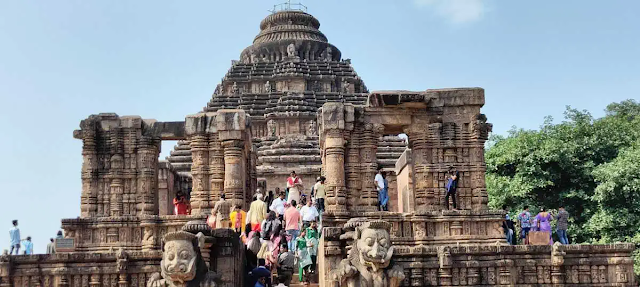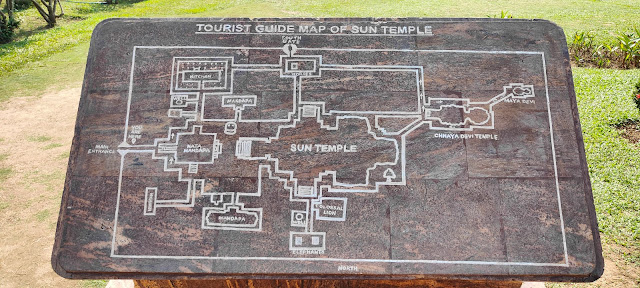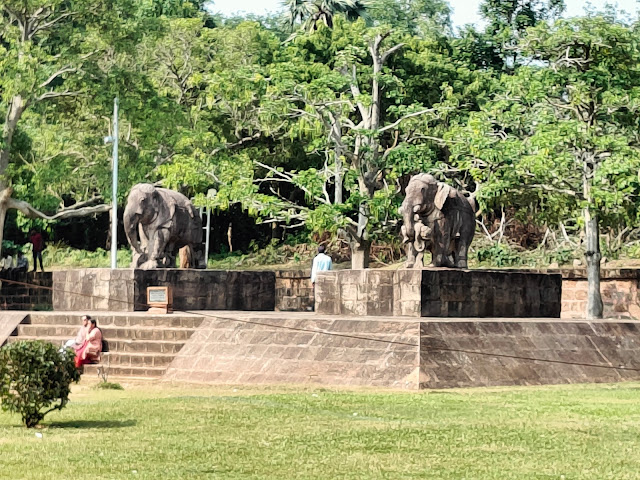Siasat.com/Featured News/Sun Temple at Konark is great but mosquito menace greater; inaction by ASI is appalling
A billboard warns visitors: “Mosquitoes are present in the show area. For your safety use proper insect repellent and take extra precautions.” Can’t the ASI make proper arrangements for the visitors who come from far and wide across the globe, especially against dangerous mosquitoes?
Follow on Twitter| Updated: 22nd December 2023 1:37 pm IS
UNESCO world heritage site, the Sun Temple at Konark in Odisha, is one of the most visited places in the country over the years.
Nobel laureate Rabindranath Tagore described the iconic Sun Temple at Konark as “Here the language of stone surpasses the language of man.”
The name is after the presiding deity Konarka, meaning Arka (Sun) of Kona (corner).
Built in the 12th Century AD by King Narasimha Deva I and dedicated to Sun God Surya, the 227-foot-tall temple leaves visitors spellbound with its intricate architecture, massive structure, symmetry, precision, and intricate carvings.
The temple was designed as a chariot of the Sun God driven by 24 beautifully carved wheels in granite and pulled by seven horses. Some of the architecture, including horses, is damaged and in ruins, while some are still intact like the giant Konark Chakra.
Sun Temple is also called Black Pagoda due to the darkish roof of the temple.
While it is called the Sun Temple, there is no Sun God in the temple, and has a story of its own. It is one of the most visited sites in the country from across the world. The visitors also make it a point to attend the Light and Sound shows in the evening.
The annual Konark dance festival held from December 1 to 5 annually is one of the most prestigious classical dance festivals in the country at the open theatre with the temple as its backdrop.
According to ASI Bhubaneswar Circle, it is one of the most visited temples in the country, accounting for over 6,72,000 domestic visitors last year besides thousands of foreigners, and continues to rise annually.
Mosquito
menace
But what attracts visitors at the Sun Temple, especially for the light and sound show in the evening, is the mosquito warning.
Sounds incredible, but it’s true and, the Archaeological Survey of India (ASI), the custodian of the famed monument, has put up a notice for the visitors.
A billboard warns visitors: “Mosquitoes are present in the show area. For your safety use proper insect repellent and take extra precautions.”
There are two shows in the evening with limited seats. The first show begins at 6.30 pm and the Second at 7.30 pm where plastic chairs are placed on the lawns and the visitor is given a headphone and receiver, which has to be returned after the show.
The show can be watched in three languages Odia, Hindi and English. While the temple is open to the public from 6-00 am to 8-00 pm daily and the ticket is priced at Rs 30 per head, the Light and Sound show ticket costs Rs 50 per head.
Given the open space grass, and greenery all-round, mosquitos rule the roost, forcing visitors to cover themselves with shawls or stay at the mercy of mosquitos.
Since most visitors get an alert on the billboard after reaching the venue, rarely does one carry a mosquito repellent with them. The tourists have to put up with the nuisance or be bitten by roaming mosquitoes.
Moreover, there is no closed sitting area for waiting tourists for the second show which begins at 7.30 pm. The security officials send away tourists from the venue and they have to return 15 minutes before the beginning of the show.
Asked why ASI doesn’t undertake fogging operations before such shows instead of asking visitors to carry a mosquito repellent, a security official said this should be brought to the notice of higher authorities. Visitors are allowed half an hour before each show while the ticket counter for the first show is opened at 5.30 pm.
Visitors picked a quarrel with the security to allow them and wait for the second show. “You should tell them (senior officials) directly. They don’t listen to us. Please write about them,” an official pleaded.
Moreover, visitors to the second show have to stand outside the main gate till the first show is over in the chilly winter.
There are no waiting rooms or toilets for those waiting for the show outside. Most rush to the nearest restaurants.
Can’t the ASI make proper arrangements for visitors who come from far and wide across the country and globe, especially against dangerous mosquitoes?
Konarak – Sun Temple – History ASI--Photos
Konarak is a village located at a distance of 66 km from Bhubaneswar, the capital of Orissa and is famous for the Sun Temple, which marks the highest point of achievement in the temple construction of Kalinga order in Orissa.
The Sun Temple, even in the ruined form presents a majestic appearance in the midst of vast stretch of sand. The name is after the presiding deity Konarka, the meaning of which is Arka (Sun) of kona (corner).
The European travellers called the main temple as ‘Black Pagoda’ while the Puri Temple was known as ‘White Pagoda’, probably due to the colour of these temples when viewed from a distance from the coast.
The black colour of Sun Temple could be due to the accumulation of moss, lichen and other fungal growth which turned the surface of the temple into black colour.
The legends attribute the temple to the Puranic age, and references are found in the Bhavishya and Samba Purana.
This tradition is carried forward in the Kapila-Samhita, the Madala-panji (chronicle of the Jagannatha temple of Puri) and the Prachi-mahatmya.
The traditions attribute the construction of the temple to Samba, the son of Lord Krishna, who after a curse suffering from leprosy, did a severe penance for twelve years to get himself cured.
Samba cured of his illness by the god, decided to construct the temple, and took a holy dip in Chandrabhaga and discovered the image of god, which was fashioned out of Surya’s body by Visvakarma. The tradition also attributes that Samba installed this image in the temple built by him in Mitravana.
The unpublished manuscript of Madala-panji mentions that a temple of Konarka-deva was constructed by one Purandara-kesari of Kesari dynasty in the Arka-khsetra.
The Ganga dynasty, which succeeded the Kesaris and Narasimhadeva, the son of Anangabhima constructed a temple in front of the temple built by Purandara-kesari and installed the image in the new temple.
Narasimhadeva caused this new temple to relieve his father’s sin by not fulfilling the promise made to the God of Puri to enlarge the temple.
Even though the tradition attributed in the Matala-panji is not reliable, the ground evidence at Konarak indicates that the main temple is constructed in front of a smaller temple, which might mark the location of the temple constructed by Purandara-kesari.
The copper plates of the successors of Ganga king Narasimhadeva (ca. 1238-1264) too mention Narasimha as the builder of a mahat-kutira (great cottage) of Ushnarasmi (Surya) in the corner of Trikona (Trikona-kone kutirakam-achikarad-Ushnarasmeh). The identification of Purandara-kesari is also doubtful. Some scholars feel that Purandara-kesari may be identifiable with Somavamsi Puranjaya (7th century A.D.) grandson of Udyotakesari and brother of Karna.
The reason for selection of this site is not known. The temple for Sun could have been constructed because he is believed to the healer of diseases and bestower of wishes from very early times.
The temple became very much popular during later times and the Vaishnavite saint Chaitanya (1486-1533 A.D.) visited the temple. Abu’l Fazl also mentions the temple in his A’in-i-Akbari.
Abu’l Fazl describes the temple in details, but not its destruction or state of preservation. It indicates that during that time the temple was in good condition and did not face any destruction.
The Madala-panji also mentions that in 1628 A.D. the temple was visited by Maharaja Narasimhadeva, the third king of Bhoi dynasty of Khurda, when Bakhar Khan was ruling the suba of Orissa on behalf of Shah Jahan.
The Marathas during the 18th century removed the Aruna-stambha made of chlorite and placed it in front of the Puri temple.
The exact cause of the collapse of the main sikhara is also not fully understood. Various speculations have been made and various causes have been attributed to its collapse, like the damage caused due to an earthquake, loose foundation and settlement and non-completion of the temple itself.
The last theory has been discarded by the scholars. Evidence for uneven settlement of plinth or sagging foundation is also not available and hence it is generally agreed that after the temple fell into disuse, the damage was caused gradually and slowly.
The periodic structural repairs which were necessary could not be made after the desecration of the temple and hence the stone elements, particularly the massive amalaka and the khapura members could have created heavy load over the superstructure and caused the deterioration to advance rapidly.
The fact that the decay and collapse was gradual is substantiated by A. Stirling, who visited the site in 1825 A.D. who mentions that the temple still stands, even in 1848, and a corner of the rekha sikhara remained to a considerable height.
The standing corner of the tower was further recorded by James Fergusson in 1837 A.D. who estimates its height as 140 to 150 feet (nearly 45 m) and Kittoe in 1838 A.D. who estimates its height as 80 or 100 feet (ranging between 24 and 30 m).
This solitary remnant of the main temple also fell in October 1848 due to a strong gale. The visit of Rajendralala in 1868 mentions it as only an “enormous mass of stones studded with a few papal trees here and there”.
Photos by C R Gowri Shanker
DECEMBER 10, 2023 SUNDAY
Konark Museum photos:















































































































No comments:
Post a Comment